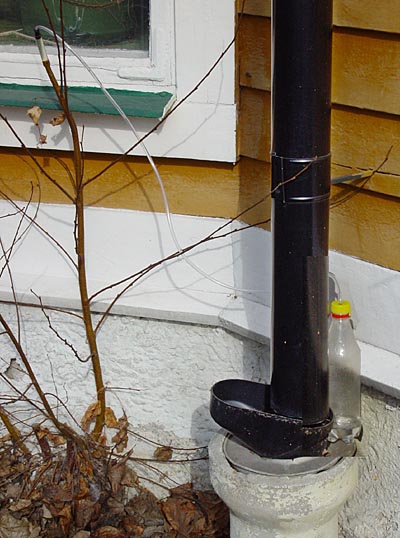This is a description how to collect birch sap from your own birch as a beverage for a family of four.
During the summer, the birch tree stores nourishment for the next period of growth in its roots. The following spring, this nourishment rises as sap through the trunk up to the branches.
Push a plastic pipe connector for cable pipes (19 mm outer diameter) into the hole.
Strap a beverage bottle (1.5 litres) with funnel to the trunk using a luggage strap. Caution! Do not use a glass bottle for sap collection as this may crack during frosty nights.
Note: If you want to drill a hole in a tree which is not your own, you might need the permission of the landowner.
Note: Birch sap to be tested as a remedy against birch pollen allergy should be as fresh as possible. The sap must not be treated in any way and must under no circumstances be boiled! Whether possibly active substances survive freezing or the addition of e.g. some preservative has not been investigated. Therefore such treatment of the sap is not recommended!
Copyright 2003 Petra Ossowski Larsson
The birch tree emits sap only for a short period of time (about four weeks) during spring. That period starts when the snow has melted away and the day-temperature reaches some degrees above freezing point. The rise of the sap stops immediately when the tree comes into leaf.
During sap-rising, a big old birch can give 15-20 litres per day, but this requires a tapping-hole of 5 cm diameter and 10 cm depth. The birch will endure such treatment only once, maybe twice in its lifetime.
To be more careful with the tree, perhaps in order to be able to tap some sap every year, you could be content with a smaller hole, e.g. with 2 cm diameter and 2 cm depth. This will give about 3 litres per day, at least in the beginning of the sap period. This is what I did (finished within 5 minutes):
This is what I did (finished within 5 minutes):
Drill a hole with an 18 mm installation drill about 2 cm aslant up into the trunk a bit above the ground. The sap starts dripping immediately.

Alternatively, you could cut off a branch and let the sap drip from the stub into a (plastic)bottle tied to it.
It is even possible to tap sap from a tiny birch shoot, but this will of course not yield very much. I cut off the top of a meter-high shoot which grew near the wall of our house and installed a collection device as shown in the picture below. This yielded half a glass of sap every day for two weeks. The sap was really sweet and aromatic! When sap-rising is over and the tap-hole has become dry you can seal it with grafting-wax or tree balm. Then press a bottle cork or wooden plug into the hole. This will protect the tree against rot.
When sap-rising is over and the tap-hole has become dry you can seal it with grafting-wax or tree balm. Then press a bottle cork or wooden plug into the hole. This will protect the tree against rot.